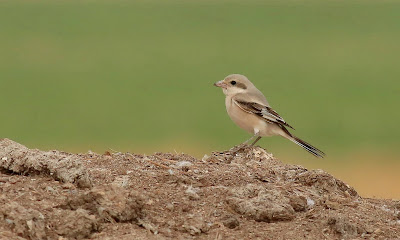Nevertheless it had some effect on Saeed Shanfari's and my birding when we went out into the desert north of the Dhofar mountains.
Having set off at 4.30 am we arrived at Dowkah farm at 6.30 am. The cyclone gave us cloudy weather all through the session there. Although the cyclone was very bad news for many, ironically it was good news for us. Birding was very pleasant.
We visited a field that was being watered next to the farm house first. Here we noticed a red-wattled lapwing. This is a bird normally found in northern Oman though some wander including this one.
Saeed Shanfari captured it in flight. Indeed many of the pictures in today's blog are Saeed's and I am very grateful that he has allowed me to reproduce them.
red-wattled lapwing (by Saeed Shanfari)
Two grey heron were attracted to the sprayers.
grey heron
Two little egret were present there too.
little egret
Having looked at this field we headed on foot towards the bushy and wooded area which is famous for its migrants.
steppe grey shrike
On the way we came across a pallidirostis steppe grey shrike. This is an uncommon wintering bird to Dhofar.
In the bushes, we saw several migrants. There was a male common redstart, a male blackcap and two lesser whitethroat.
first lesser whitethroat
I came across them when Saeed and I divided up looking in the bushes. I took one end and he took the other.
second lesser whitethroat
At Saeed's end there was a common whitethroat.
common whitethroat
At both ends and indeed throughout the farm there were spotted flycatcher.
spotted flycatcher
Huge numbers pass through Dhofar especially in autumn. Though the numbers are highest in September, they still keep coming.
close-up of a spotted flycatcher
Resident house sparrow are numerous in both the bushes and the near-by trees which included rows of palms.
house sparrow by Saeed Shanfari
Only one golden oriole was seen at the farm and this was high in the tallest tree. This was noticed as we moved from the bushes to the trees.
The palms held two European scops owl, presumably the same birds I had seen a month before in the same place. Saeed has a passion for owls and he took some very good pictures.
European scops owl peeking (by Saeed Shanfari)
European scops owl (by Saeed Shanfari)
I wonder if survival is the issue or whether many seen at desert stops further migrate to places such as the mountains of Dhofar alongside Arabian scops owl.
I don't think that people should automatically assume they have seen an Arabian scops owl just because it is a scops owl in a Dhofar wadi.
peeking again (by Saeed Shanfari)
All the time we were at the farm we kept seeing three marsh harrier. Mostly they were over the fields but sometimes over the wooded area.
marsh harrier (by Saeed Shanfari)
After the trees, we headed out to more fields. Desert wheatear numbers are now typically high for winter.
desert wheatear
Although only one golden oriole was seen, several European roller were still present.
European roller
Towards the end of our session at the farm, a flock of blue-cheeked bee-eater arrived.
blue-cheeked bee-eater
There are groups of tawny pipit as well as white wagtail in the fields.
tawny pipit
While desert wheatear are numerous, there was also a scattering of Isabelline wheatear.
Isabelline wheatear
One late common rock thrush was seen as one of the last birds before we left the site.
common rock thrush
The cloudy sky had meant temperatures were much lower than usual. We left
without the usual tiredness caused by three hours walking in the desert heat.
We went on to visit three more desert stops during the day. By the end of the day I had another addition to my Oman lst. I will blog about this next.





















No comments:
Post a Comment